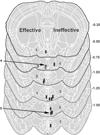Suprachiasmatic nucleus as the site of androgen action on circadian rhythms
- PMID: 26012711
- PMCID: PMC4546904
- DOI: 10.1016/j.yhbeh.2015.05.007
Suprachiasmatic nucleus as the site of androgen action on circadian rhythms
Abstract
Androgens act widely in the body in both central and peripheral sites. Prior studies indicate that in the mouse, suprachiasmatic nucleus (SCN) cells bear androgen receptors (ARs). The SCN of the hypothalamus in mammals is the locus of a brain clock that regulates circadian rhythms in physiology and behavior. Gonadectomy results in reduced AR expression in the SCN and in marked lengthening of the period of free-running activity rhythms. Both responses are restored by systemic administration of androgens, but the site of action remains unknown. Our goal was to determine whether intracranial androgen implants targeted to the SCN are sufficient to restore the characteristic free-running period in gonadectomized male mice. The results indicate that hypothalamic implants of testosterone propionate in or very near the SCN produce both anatomical and behavioral effects, namely increased AR expression in the SCN and restored period of free-running locomotor activity. The effect of the implant on the period of the free-running locomotor rhythm is positively correlated with the amount of AR expression in the SCN. There is no such correlation of period change with amount of AR expression in other brain regions examined, namely the preoptic area, bed nucleus of the stria terminalis and premammillary nucleus. We conclude that the SCN is the site of action of androgen effects on the period of circadian activity rhythmicity.
Keywords: Androgen receptor; Brain clock; Free-running period; Hypothalamus; Light; Locomotor activity; Sex difference; Sex steroid; Testosterone.
Copyright © 2015 Elsevier Inc. All rights reserved.
Figures






Similar articles
-
A role for androgens in regulating circadian behavior and the suprachiasmatic nucleus.Endocrinology. 2007 Nov;148(11):5487-95. doi: 10.1210/en.2007-0775. Epub 2007 Aug 16. Endocrinology. 2007. PMID: 17702841 Free PMC article.
-
Dose-dependent effects of androgens on the circadian timing system and its response to light.Endocrinology. 2012 May;153(5):2344-52. doi: 10.1210/en.2011-1842. Epub 2012 Apr 4. Endocrinology. 2012. PMID: 22492303 Free PMC article.
-
Gonadectomy reveals sex differences in circadian rhythms and suprachiasmatic nucleus androgen receptors in mice.Horm Behav. 2008 Mar;53(3):422-30. doi: 10.1016/j.yhbeh.2007.11.014. Epub 2007 Dec 4. Horm Behav. 2008. PMID: 18164002 Free PMC article.
-
Sex differences in circadian timing systems: implications for disease.Front Neuroendocrinol. 2014 Jan;35(1):111-39. doi: 10.1016/j.yfrne.2013.11.003. Epub 2013 Nov 25. Front Neuroendocrinol. 2014. PMID: 24287074 Free PMC article. Review.
-
Minireview: The neuroendocrinology of the suprachiasmatic nucleus as a conductor of body time in mammals.Endocrinology. 2007 Dec;148(12):5640-7. doi: 10.1210/en.2007-1083. Epub 2007 Sep 27. Endocrinology. 2007. PMID: 17901227 Free PMC article. Review.
Cited by
-
Connecting the Dots: Potential Interactions Between Sex Hormones and the Circadian System During Memory Consolidation.J Biol Rhythms. 2023 Dec;38(6):537-555. doi: 10.1177/07487304231184761. Epub 2023 Jul 19. J Biol Rhythms. 2023. PMID: 37464775 Free PMC article.
-
De novo and inherited TCF20 pathogenic variants are associated with intellectual disability, dysmorphic features, hypotonia, and neurological impairments with similarities to Smith-Magenis syndrome.Genome Med. 2019 Feb 28;11(1):12. doi: 10.1186/s13073-019-0623-0. Genome Med. 2019. PMID: 30819258 Free PMC article.
-
Effects of testosterone on circadian rhythmicity in old mice.J Physiol Sci. 2019 Sep;69(5):791-798. doi: 10.1007/s12576-019-00695-4. Epub 2019 Jul 12. J Physiol Sci. 2019. PMID: 31301005 Free PMC article.
-
Orchiectomy Decreases Locomotor Activity and Delays the Expression of the Clock Protein PER1 in the Suprachiasmatic Nucleus in Rabbits.Animals (Basel). 2024 Dec 11;14(24):3570. doi: 10.3390/ani14243570. Animals (Basel). 2024. PMID: 39765474 Free PMC article.
-
Flexible clock systems: adjusting the temporal programme.Philos Trans R Soc Lond B Biol Sci. 2017 Nov 19;372(1734):20160254. doi: 10.1098/rstb.2016.0254. Philos Trans R Soc Lond B Biol Sci. 2017. PMID: 28993498 Free PMC article. Review.
References
-
- Aschoff J. Exogenous and endogenous components in circadian rhythms. Cold Spring Harbor symposia on quantitative biology. 1960;25:11–28. - PubMed
-
- Blattner MS, Mahoney MM. Circadian parameters are altered in two strains of mice with transgenic modifications of estrogen receptor subtype 1. Genes, brain, and behavior. 2012;11:828–836. - PubMed
-
- Brockman R, Bunick D, Mahoney MM. Estradiol deficiency during development modulates the expression of circadian and daily rhythms in male and female aromatase knockout mice. Hormones and behavior. 2011;60:439–447. - PubMed
Publication types
MeSH terms
Substances
Grants and funding
LinkOut - more resources
Full Text Sources
Other Literature Sources
Research Materials

